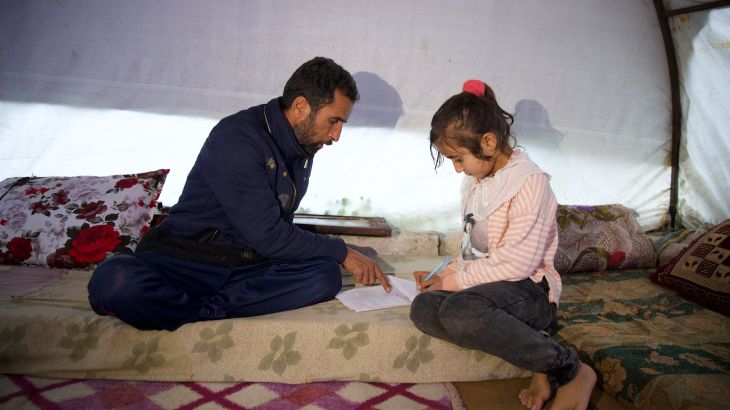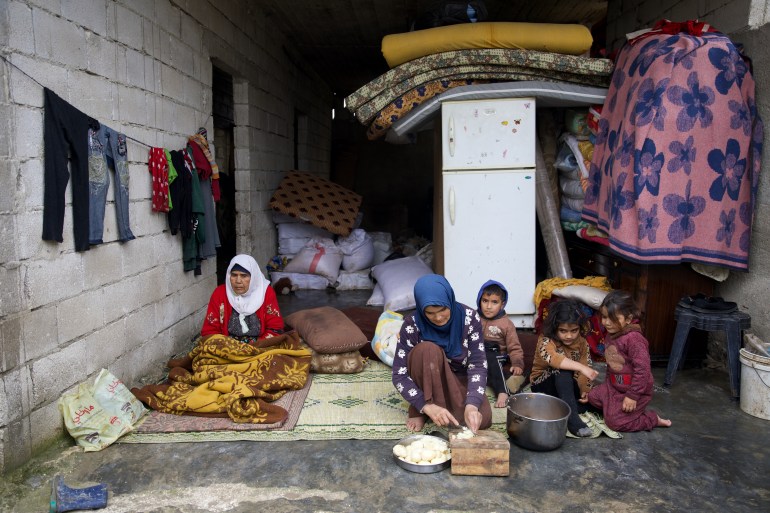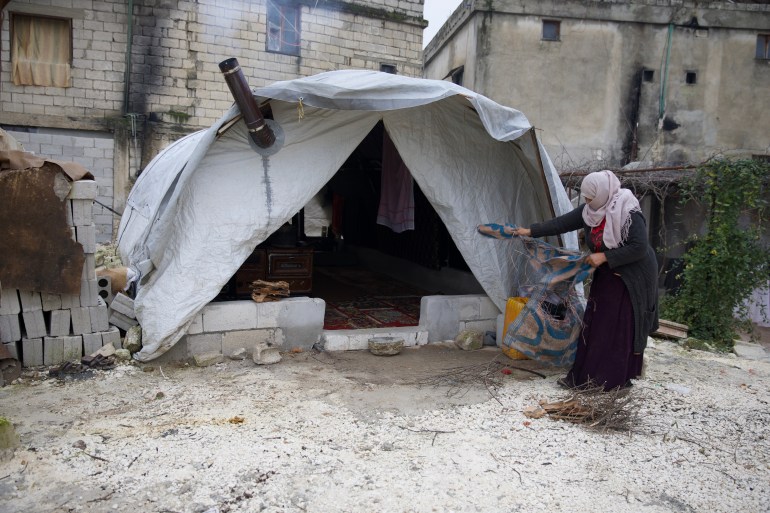Since the earthquake, these northwest Syrian villagers camp out every night
Many villagers spend the day in their homes, then sleep in tents outside for fear of aftershocks.

Idlib, Syria – At the foot of the Orontes River, in the northern countryside of Idlib, lies the village of al-Hamziyah, once known for its lush, fertile lands.
Now, as the sun sets every day, it turns into a refugee camp for the villagers.
Keep reading
list of 4 itemsEarthquake fever grips Turkey’s Istanbul amid fears of ‘the big one’
Paint and tears: Northwest Syria commemorates 2023 earthquakes
‘She was the one’: Finding love in the midst of Turkey’s earthquake
Although it has been a year since the February 6 earthquake, the temblor’s effects are still evident on the village’s homes, where you can find cracked walls, and on the fields collapsing with the weight of the water that flooded them.
And, near every house, there is a tent for a family too frightened to sleep inside their house.
No longer habitable
“I fear that the earth will shake and that the Orontes will swallow us,” Yasmine Misto, who is in her 30s, said.
Yasmine, her husband Khaled, their 10 children and her mother-in-law all sleep in a leaky tent with rainwater constantly trickling in near their house, which collapsed partially in the earthquake.
“I was six months pregnant, and at first I thought I was feeling dizzy. I didn’t realise it was an earthquake,” Yasmine said, describing the panic of one year ago as she scrambled to save her children and mother-in-law, terrified the whole time and thinking that the house would fall on their heads.

Yasmine gave birth a month later, in her seventh month, to a premature baby boy who has thrived and grown since those stressful early days and keeps them very busy in the tent.
The family’s house is no longer habitable, and it was only a few days ago that Yasmine was finally able to dig out some utensils from under the ruins of the kitchen to start using them again in the tent.
Yasmine and her husband were agricultural labourers, but when the Orontes overflowed its banks in the earthquake and permanently expanded its basin, many fields were inundated and work opportunities became very hard to come by.
“We couldn’t fix anything in our house,” Yasmine said. “We could barely afford bread, diapers, and medicine.”
But Yasmine is fine with that, as she feels the tent is safer than the house. “I get scared when I hear mention of the earthquake, and I feel like my heart has aged 10 years,” she said.
Nowhere to go
The muddy streets of al-Hamziyah are filled with stories of loss and constant fear.
The story of Abdul Karim al-Nisa and his family is not much different from Yasmine’s – they also spend the day in their house, whose walls are cracked, and sleep in a simple tent nearby.

“I repaired a lot of the damage. I paid more than $1,000 so far,” Abdul Karim, 40, told Al Jazeera, pointing to the house he is still afraid to live in. The amount is no small sum for him.
Abdul Karim tries to track news of the earthquake and aftershocks through social media groups that have been a hotbed of rumours and unscientific predictions over the past months, causing constant anxiety for survivors.
“I will never forget the earthquake until I die,” he said. “I never feel safe because of aftershocks.
Whenever I read that an earthquake is going to happen, I rush out to the tent with my family.”
Despite the inconvenience of living between the tent and the damaged house, Abdul Karim feels helpless because he does not see where else he can move in an area with little security and few opportunities to find a decent home.
Northwestern Syria, which is the last opposition enclave in the country, is besieged, with the Turkish border closed to the north and the Syrian Democratic Forces and the regime surrounding its internal borders.

United Nations estimates at the beginning of 2023 showed that about 2.1 million people needed shelter services out of 4.5 million residing in the northwest, including 1.7 million residing in informal camps, and 800,000 living in tents, 90 percent of which are old and worn out.
After the earthquake, which damaged 10,600 buildings, 53,000 families were displaced, and assessments published two months after the disaster showed that about 855,000 people’s homes needed renovation and repair to be safe again.
Trauma and constant danger
Younis Shamat, local council head in al-Hamziyah, thinks it is probably normal that people prefer to move between their homes and tents after what happened.
Of the 500 families residing in the village, 62 lost their homes completely, while 70 percent of the remaining homes became uninhabitable due to damages.
“Ninety percent of the houses have cracked and aftershocks affect them, so people no longer feel safe to live in them,” Shamat told Al Jazeera.

In the northwest, 148 towns and cities were damaged by the earthquake, according to the UN, with most of them in Afrin in the northern Aleppo countryside and Harem in the Idlib countryside, where al-Hamziyah is located.
Shamat believes that villages did not receive the attention that the major urban centres did.
Twenty percent of the village’s population received financial aid to renovate their homes, and 40 families were given tents by humanitarian organisations, while aid for the rest of the population was limited to food baskets.
People who did not get financial assistance to fix their homes have not been able to do so, Shamat said, adding that most of the assistance was for homes with minor damage.
Before the earthquake, the residents of the village relied on their fields and what they were able to grow for food, but the damage to the fields means that is no longer an option.
On top of all that, the continuing aftershocks mean that stability and security are a far-away dream for Yasmine, Abdul Karim, and the rest of the families in the village, whose only plan to deal with the earthquake’s aftermath is to keep staying in their tents as long as they can.
![[Ali Haj Suleiman/Al Jazeera]](/wp-content/uploads/2024/02/DJI_0868-1707145649.jpg?w=770&resize=770%2C578)